In the spring of each owner of the household site, I want to get out of the house and admire the bright and gentle flowers that were so lacked during the long and cold winter months. It is with the first rays of the sun with particular popularity and love of primroses that reveal their buds immediately after melting snow.
Among the huge variety of spring colors, hyacinths are especially allocated, which will be able to hit by their incredible appearance. Despite the fact that the homeland of these gentle flowers is the territory of Northern Africa and Asia, hyacinths with proper care can grow perfectly in the middle lane and even in Siberia. If you make some efforts and carefully follow all the rules of agrotechnology of cultivation, in the spring you can admire all the shades of hyacinth colors.
In this article, consider the features and description of hyacinths, we note the characteristics of species suitable for the territory of Siberia and varieties of this plant. We give important rules and nuances of landing and the care of hyacinths in Siberia.
Features and morphological description of hyacinths
Among all the first colors, hyacinths are highlighted by their bright and very tender appearance. That is why this flower is trying to plant in the fall, so that in the spring it is possible to admire it with flowering. In addition, various varieties of hyacinths begin to actively sell in all flower shops already for the holiday of March 8, as they enjoy great demand and popularity as a gift.
Hyacinth is a perennial bulbous plant with beautiful flowers, which relates to the family of asparagus. This classification appeared quite recently, since previously hyacinths were referred to a separate hyacinth family, and at the same time were included in the Lily family. The territory of the countries of the Mediterranean, as well as Southeast Asia is considered to be the homeland of these wonderful plants. It can be noted that the south of the territories of the North Caucasus hyacinth can be found in the wild, where these small flowers prefer to grow on the slopes of the mountains and in the valleys.
Translated from Greek hyacinth or Hyacinthus translates as a "rain flower", which is due to the fact that its flowering in the territory of ancient Greece has always fallen on the rain period. The people are also often referred to as Hyacinth "Flower Sobble", all because of the same rainy season. There is another legend about the appearance of the flower itself on Earth, thanks to which hyacinth is often called a "memory flower". The flower name was in honor of the hero of the ancient Greek myth of Hyacinth, who lived in those distant times and was the son of King Sparta. This beautiful young man was friends with Apollo, together they learned to throw the disk. During one of these training, Hyacinth ran to the disk, but the God of West Wind, secretly in love with the young man, turned the disk and he hit the Hyacinth. Apollo in memory of his friend from his blood created a beautiful and gentle flower.
Description of hyacinth:
- As already noted, the hyacinth is a bulbous plant that is suitable for growing in the open ground, for early distillation and for cutting. With proper care, it is possible to grow hyacinths even on the territory of Siberia, the main thing is to clearly know all the dates for the landing and nuances of the departure.
- Hyacintes are considered the earliest spring flowers, the natural habitat of which are considered predominantly southern territories. However, it was in Holland that a colossal work was done to eliminate and distribute new weather resistant varieties of this flower.
- The root system of hyacinth is represented by a bulb. It has a sufficiently dense structure, consists of juicy lower leaves, which go to the very Donets. Before planting, the diameter of the bulbs should be about 4 cm, and the lower leaves should be counted 4-6 pieces.
- From the bulbs, the stem of hyacinth, which is a continuation of the Donette. In length, the stem can be approximately 30-40 cm. After the end of the flowering, the stem completely dries.
- Stem is dense and quite thick, green.
- At the base of the stem, long narrow leaves are formed, which are slightly folded along the entire length. The hue of the hyacinth foliage saturated green, which beautifully shams the bright colors of this plant.
- In the corners of the leaves, the so-called kids are formed, which can be used for the vegetative reproduction of hyacinths.
- One plant can give only one stem, the top of which is marked with inflorescence.
- Flowers in hyacinths are small, have a bell-shaped shape with curved petals. Collected on top, flowers form a cysterified inflorescence in the form of a cylinder or cone. In one infloretia, approximately 20-30 buds, which possess a pleasant aroma.
- In terms of its structure, flowers may be simple or terry, which also underlies one of the classifications of hyacinth varieties.
- Pleases the eyes and color palette of hyacinths. Depending on the specific variety, the petals of this flower can be painted in white or cream shades, blue, blue, purple, pink, red, burgundy. There are colors in monophonic, however, there are also varieties that have petals have a white edging.
- After the scene of the colors of the hyacinth, fruits begin to be formed, which are three-travelers, inside each one is two seeds with tender peel.
- Hyacinths are characterized by simplicity in cultivation and care. However, to obtain beautiful plants with bright and magnificent inflorescences, it is important to correctly pick up the landing time. For the territory of Siberia, this is especially true, as it is important to land the bulbs in September or in early October.
Types and varieties of hyacinths for Siberia
Earlier, all hyacinths were divided into about 30 different species, however, after changing the classification, all numerous varieties of this beautiful flower were distributed in three main types. This is Hyacinth East, Hyacinth Custinian and Hyacinth Litvinova. It is due to these types of light that the numerous spectacular varieties of this flower appeared, which today are actively grown worldwide both in open ground and at home. Oriental hyacinths are best suited for the territory of Siberia and the middle strip of Russia, which have better endurance indicators. All grades of hyacinths are also accepted to divide in the structure of inflorescences for simple and terry. Frequently used classification by flowering time: early and late. However, all gardeners have particularly liked the structure, where all the varieties of this plant are separated by the color of inflorescences. Consider the characteristics suitable for Siberia varieties of the eastern hyacinth.
- Grade "Perle Brilliant". Very beautiful hyacinth grade, which is a plant height up to 25 cm. Refers to late varieties. Differs in bright blue inflorescences that bloom for 3 weeks.
- Grade of hyacinths "Marie". The plant relates to early grades. It is a hyacinth with spectacular dark blue flowers with a longitudinal purple strip. The flowering of this variety lasts for 16-18 days. You can plant in an open ground or in pots for trampling.
- Grade "Queen of the Blues". In height, this plant can reach approximately 25-30 cm. It blooms this hyacinth with light blue flowers with a pleasant aroma. Refers to the middle flowering juices, which lasts for 2 weeks.
- Grade of hyacinths "Blue Majik". This flower is characterized by spectacular purple-violet petals. In height, the plant of this variety can reach about 25 cm. The flowering lasts about 2 weeks. Hyacinth "Blue Magic" refers to a group of varieties with an average flowering period.
- Hyacinth "Indigo King". It is a variety of low growth. The arrow can reach 17-18 cm. Petals are painted in a dark black and purple shade. The surface of the colors is shiny. The plant belongs to late varieties for a period of flowering, which lasts for 2 weeks.
- Grade "Bismarck". Very popular hyacinth grade, which is characterized by an early flowering period and beautiful light-violet petals with a darker longitudinal strip. The height of the hyacinth reaches 20-25 cm. The flowering lasts about 2 weeks.
- Moro variety. This is an early grade of hyacinths, which in height can reach 20-25 cm. Blossom can last up to 3 weeks, while the flowers of a pink-raspberry shade with a dark strip in the center are blooming on the stem.
- Hyacinth Anna-Maria. Unlike the previous grade, this plant blooms with light pink flower. Refers to the average duration of flowering, which lasts within 15-18 days.
- Herruda variety. Very spectacular variety with dark pink-shaped inflorescences.
- Hollyhock hyacinth grade. It is a late grade, the bloom of which lasts for two weeks. Flowers of red-raspberry shade with a terry structure. In height, this plant can reach approximately 23-25 \u200b\u200bcm.
- Grade "La Victoria". This type of hyacinth refers to early grades for flowering. It is distinguished by bright, shiny red-pink flowers that will delight their flowering for 2 weeks.
- Hyacinth grade "Snow Crystal". This is a representative of a group of colors with snow-white flowers. The structure of the colors of terry, flowering lasts about 3 weeks. In the height of the blooming can grow to 28-30 cm.
- Madame Sophie variety. It refers to the Figheri-driving varieties of hyacinths, which can be in height to reach 20-23 cm. It is a beautiful plant with terry snow-white flowers.
- Hammer's hyacinth grade. The plant belongs to the firewall of flowering. During flowering on the flowers, bright yellow flowers are blooming, which can gradually burn out in the sun. In the height, all the plant can maximize 25 cm. The flowering is long enough, it can last up to 2 weeks.
The reproduction of hyacinths in Siberia: the most common ways for this region
Great hyacinths on their plot in the conditions of the Siberian climate is not so difficult. Competently using all possible methods of reproduction of this culture, as well as observing all the rules for breeding hyacinths, you can get beautiful and abundant flowering flower beds "rain colors". For reproduction of hyacinths, several ways are suitable: seed reproduction, as well as breeding with children. In addition, to obtain a large amount of landing mariila, you can use an artificial way, for example, the reproduction of the division of the Donets. Consider the characteristics and rules of the most popular methods for the reproduction of hyacinths in Siberia.
Seed reproduction of hyacinths in Siberia
- This method of reproduction is most suitable for plant breeding, when it is necessary to bring new varieties, as in the end, young flowers do not inherit maternal signs.
- First of all, you need to purchase seeds of hyacinths. To do this, you can go to the nearest flower shop or, as an option, you can collect seeds yourself, if this handsome has already grown on your site. It is necessary to wait for a complete blowing of inflorescences and ripening seed boxes, after which it gently collect seeds. It is recommended to dry them a little in a dry and ventilated room.
- Seeds of hyacinth do not need additional stratification, however, for better germination, they can be sent for several hours in growth accelerator.
- Before sowing seeds, we definitely pay special attention to the container, which should be sufficiently free and deep for the full formation of bulbs.
- Fill the chosen container with a nutrient soil consisting of one part of the sand, one part of the leaf land and two parts by humus. After that, moisten the soil.
- Pose on the surface of the seeds of hyacinths and on top plucked sand. It is necessary to do this at about late September or early October.
- Over the next two years, seedlings must be in a cold greenhouse, after which they are planted in an open ground.
- The first bloom of hyacinths grown from seeds should be waiting only in 5-6 years. It should be remembered that young plants can be blooming completely different colors than the parent plant.
Gyacinth reproduction kids in Siberia
- This is a natural way of reproduction of hyacinths, which can be used in the cultivation of this culture in Siberia.
- This vegetative method is simple enough, but it takes a lot of time. This is due to the fact that one bulb of hyacinth per year can give an average of 1-2 small bulbs kids. In rare cases, their number can reach 3-4. Some varieties with proper care can form up to 6-8 kids on one bulb.
- Before winning the babes from the bulbs, you need to check how hard they hold on to her. If the fastening is still durable, then it is best to touch them and leave to grow on a bulb. With the easiest branch, the kids are not damaged and ready for landing.
- After separation, small bulbs are planted into containers for growing, which lasts at least 2 years. And only after that they can be planted on the flower beds.
- It is important to remember that the first years while the bulbs are still small, it is recommended to trim the inflorescences, which will allow the plant all their strength and energy to direct on the ripening and forming a strong bulb.
The reproduction of hyacinths in Siberia cutting the Donets
- This method of reproduction refers to artificial, since the appearance of children in the bulbs is provoked by certain actions of a person.
- First of all, it is necessary to select only large and tight bulbs, completely healthy and fresh. Next, they are purified from the ground, washed and dried during the week in a dry and ventilated room.
- Be sure to stock suitable tools: this is a scalpel or a conventional perochny knife, as well as a teaspoon with a sharpened sharp edge.
- Before cutting out the Dont, all tools need to be disinfected with alcohol or rolling over fire.
- The dona at the bulbs is cut out by a cone, while it is important not to touch the location of the cut slicer. Immediately after cutting them, they are processed by poured charcoal. And before cutting out each next dona, the tools are treated again to eliminate infection with fungal and viral diseases.
- Prepare drawers with a mesh bottom or containers with large wet sand. Place the harvested onion in the container up the cuts and top with the film. After that, the box with bulbs must be kept in heat and slightly shaded room with regular substrate moisture.
- Children in large quantities, on average 20-40 pieces, can begin to be formed in 2-2.5 months. And after 3.5 cm in diameter, they can be about 1 cm.
- Before October, it is imperative to land the bulbs in open ground, the surface should be thoroughly meditated.
- For the second year, the kids reach sizes 3-4 cm, after which they can be dug and transplant to a permanent place.
- Such bulbs will bloom only for 3-4 years.
In addition to the above methods for the reproduction of hyacinths, others can be used, for example, cutting of a diagram or reproduction of flakes, leaf cuttings. If we talk about breeding on the territory of Siberia, it is best to use exactly the bottom of the Donets. This is due to the fact that this method allows to obtain larger and strong bulbs, albeit in less than when the cutting cutoff is reproduced. And this is very important when growing hyacinths in a cool climate. Their difference lies in the fact that it is enough to do with a cross-shaped incision on the bottom. Further actions similar to the previous method of reproduction.
Planting hyacinths in Siberia - Phased description
The cultivation of these beautiful colors on the territory of Siberia is complex, but with a proper approach and extradiya, you can achieve impressive results.
Stage 1. Selection and purchase of landing material of hyacinths for Siberia
- First of all, each experienced or novice gardener should think about the acquisition of high-quality and healthy hyacinth bulbs, which will be the key to their full growth and development.
- For cultivation in climate conditions, Siberia is best to buy bulbs more resistant to cold weather. Special attention should be paid to varieties derived in similar climatic conditions or on zoned varieties that are already adapted to certain temperature drops and strong frost.
- It is also important to pay attention to the appearance of the planting material. It is necessary to buy the right bulbs so that they must be better and bloomed faster.
- In size, it is best to acquire medium-sized bulbs, which in diameter reach approximately 4-5 cm. Lower size planting is better not to buy, as such bulbs are still weak and not fully formed.
- The bulbs must necessarily be dry and clean, without signs of disease and pests. This is especially true of the Donets. It is best to check them on the touch - the bulbs must be elastic.
- Small roots must be present on the bottom.
Stage 2. Choosing a place and soil for landing hyacinths in Siberia
- So that hyacinths are beautiful and long bloom in Siberia, it is important to choose the right place to fit.
- These flowers prefer to grow at open solar sites, but constant straight rays of the sun are dangerous for them. Therefore, many gardeners plant bulbs under trees and shrubs, although this option also has its own minuses. First of all, hyacinths do not receive a sufficient amount of nutrients.
- The selected plot must be protected from strong wind and drafts.
- Special attention should be paid to the soil in which bulbs will be planted. Hyacinths prefer to grow in a nutritional and fertile substrate with a neutral reaction. Therefore, in the presence of sour soil, you need to make lime, and in the clay substrate it is best to add a little sand into the clay substrate.
- Do not forget about drainage, since this plant does not endure the convergence.
- The landing ground is prepared a couple of months before disembarking, in about august. It is important to remember that fresh manure is not added to the soil.
Stage 3. The process of landing hyacinths in Siberia
- The time of landing of hyacinth bulbs in Siberia to an open ground is slightly different from this process in other regions. Everything is due to the fact that winter here comes much faster, and the bulbs need time to root. Therefore, it is best to land in early September. At the same time, the landing first is necessarily hidden until the bulbs are empty root.
- It is also important to properly prepare landing wells for hyacinth bulbs, which should be placed at a distance from each other at 20-25 cm.
- The depth of one well should be three lengths of the bulb itself. At the same time, the soil layer above the bulb should be no more than two lengths of the bulbs. On average, large bulbs are plugged by about 18 cm, and the average is 12-15 cm.
- Before the landing itself, all bulbs must be placed in a solution of fungicides or a saturated solution of manganese.
- At the bottom of each well, you can add a hurry to a handful, as well as a small layer of large purple sand.
- After that, gently press in the sand of the bulbs and suck them from above with the same sand, on top of which fertile soil is saturated.
- After planting the soil watering.
Agrotechnology of growing hyacinths in Siberia: Secrets and nuances of care
- Watering. Immediately after landing in the fall, the bulbs of hyacinth need moderate watering. In the absence of rains it is important to water the plants after driving the upper layer. It is important to water in such a way as to moisten the soil to a depth of 15-20 cm. If the rains go in normal quantities, then the additional watering is not needed.
- Loosening and mulching. After each watering, it is important to gently loosen the top layer of the soil. Also do not forget about the removal of weeds that can slow down the growth of bulbs. To reduce the amount of irrigation and protect frail bulbs from nature whims, the soil around the plants can be meditated by peat.
- Feeding. If fertilizers were made during the landing, for example, the humus, then there will be no other bulbs. In the spring, it is enough to make a little nitrogen fertilizer before flowering. After the end of flowering, you can also bother with plants with superphosphates and sulfate potassium.
- Shelter for the winter. In Siberia, immediately after planting the bulbs, it is recommended to stream film or spandbon for a couple of weeks. Before the cold, it is important to pay special attention to the shelter of the bed. To do this, use a layer of mulch with a thickness of 15-20 cm. You can use humid, peat or nestball. In the spring, the shelter is removed immediately, as the soil starts.
- How to keep hyacinth bulbs in Siberia. An important factor in the breeding of hyacinths is the storage of bulbs. In approximately in June or in July, the bulbs need to dig up, as they can continue to leave deeply underground. The bulbs are neatly removed and the first week is dried in a dry room. After that, they are cleaned and sorted in size. If there are many bulbs, they are placed by layers in the box, a small amount of planting material can be stored in paper bags. The first two months of the bulbs are stored at a temperature of 25 degrees, then within 1 month you need to maintain a temperature at the level of 17 degrees. In September, the bulbs can again be planted in the ground.
Hyacinths in Siberia - Photo
Hyacinths are very beautiful and bright colors, which can also be raised in Siberia. This process, though it takes more time and requires more attention to the gardener, but as a result, you can get whole flowerbeds and girks of hyacinths of various shades.

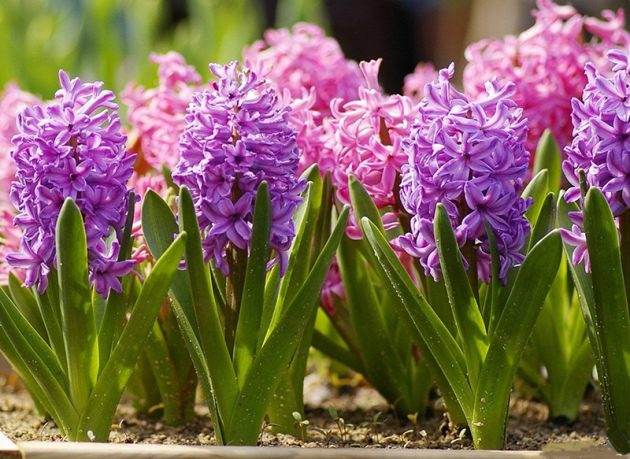
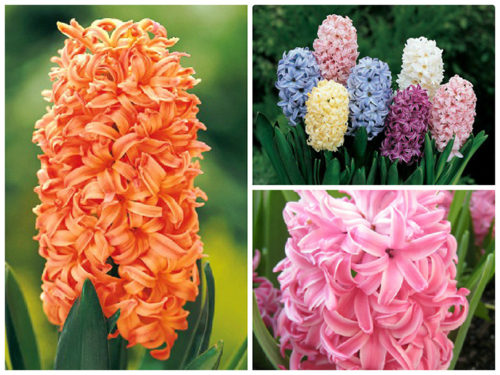
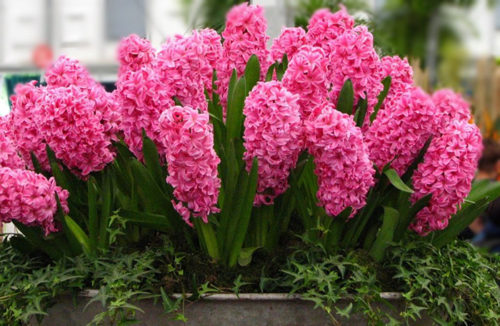
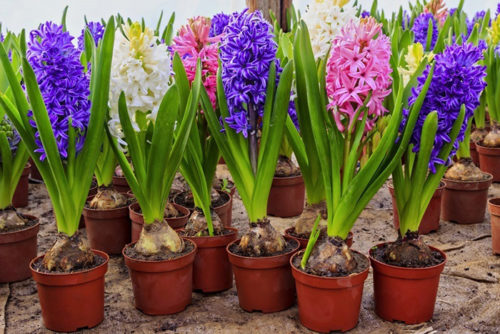
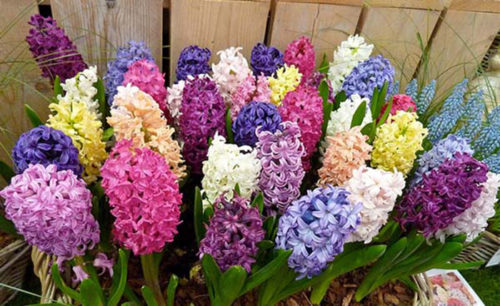
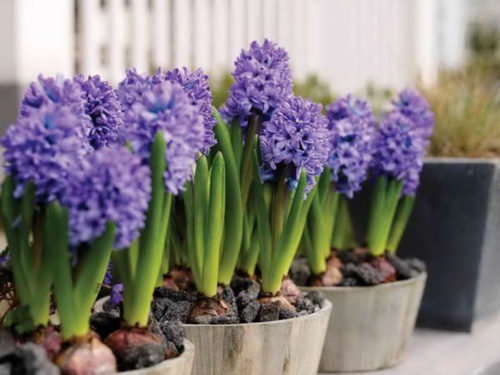
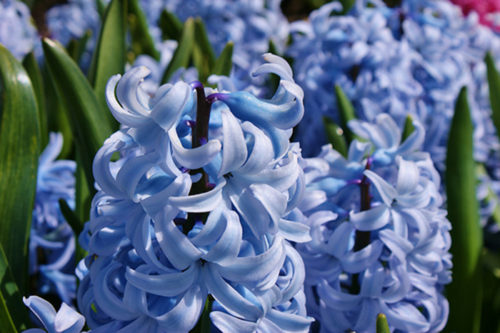
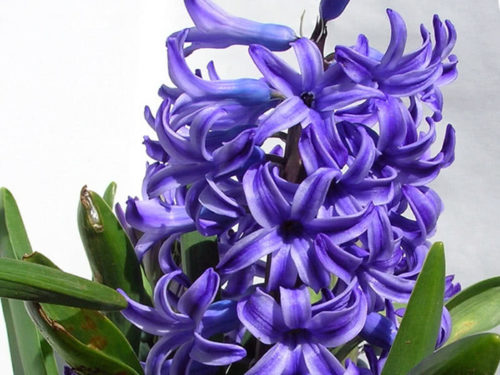

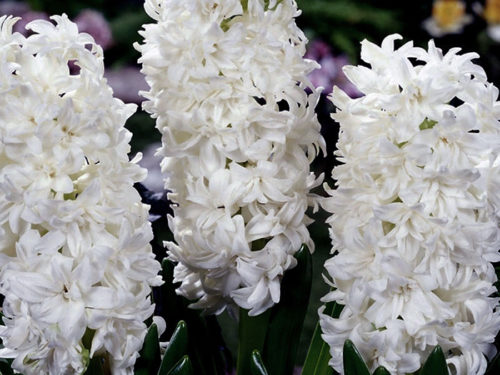

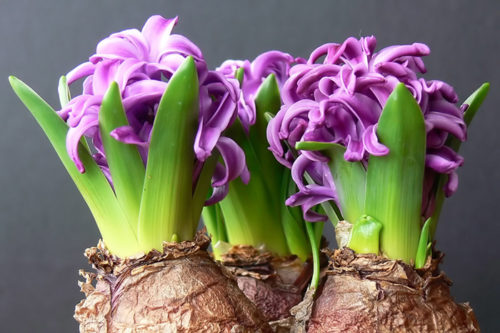
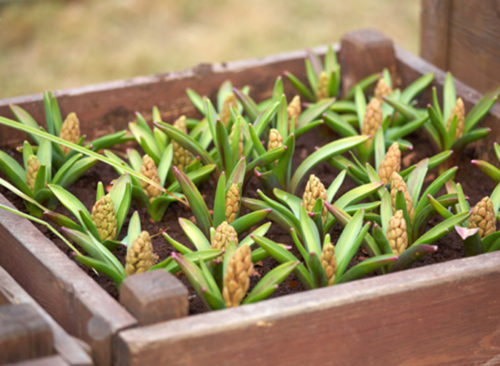
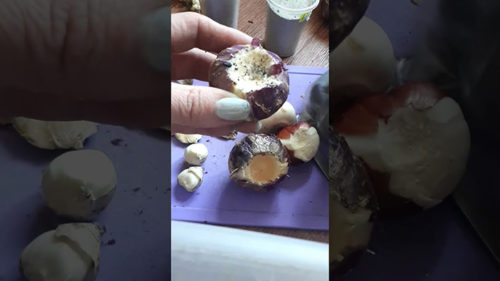
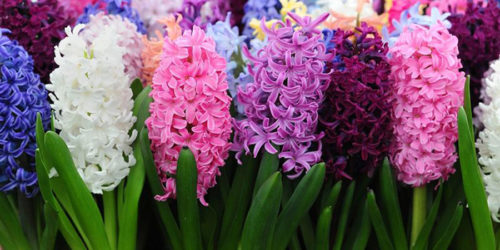
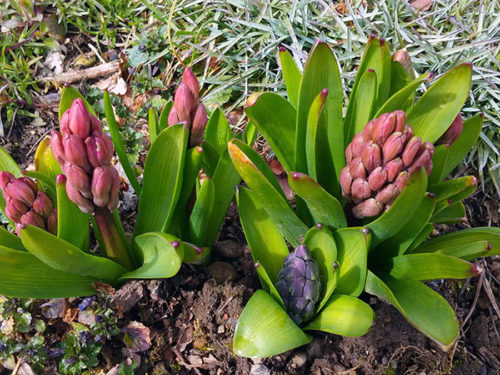
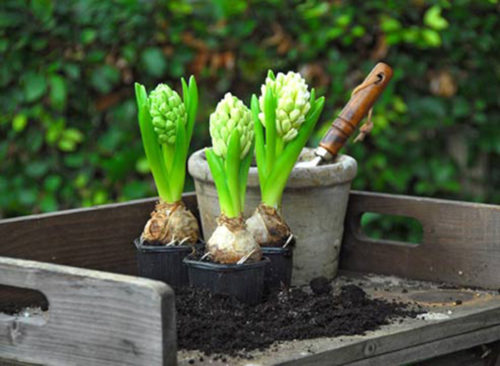

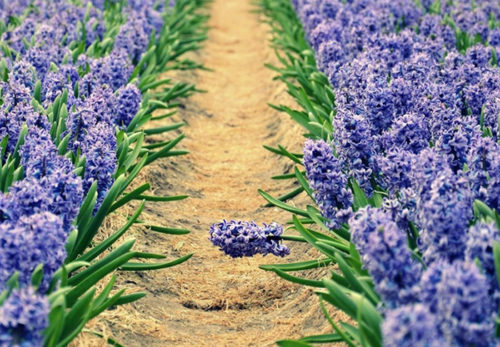
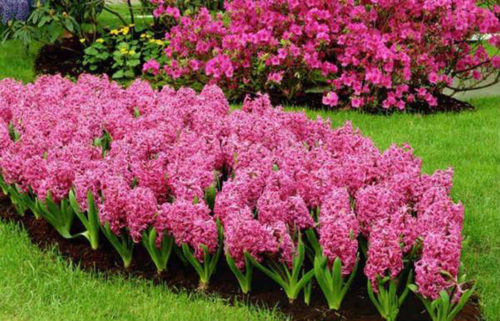
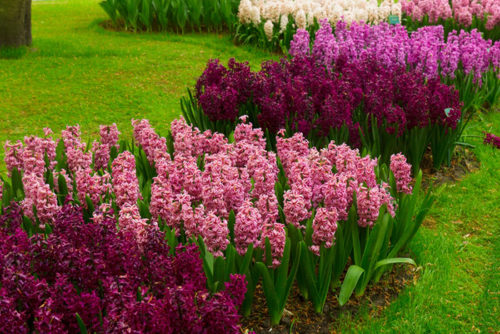
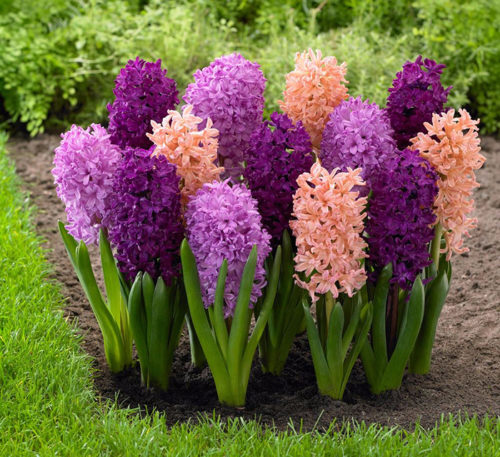













 Start a discussion ...
Start a discussion ...